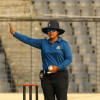Chronic condition of cringe culture

In Bangladesh cricket's latest flashpoint, the line between passion and poison blurred once more.
After a 200-run thrashing against Afghanistan in Abu Dhabi on Tuesday, part of the national team returned home the following night to a hostile reception at Dhaka's Hazrat Shahjalal International Airport. Fans hurled abuse as players exited the terminal, and the chaos was enough to raise safety concerns.
Mohammad Naim Sheikh, seated inside his car, bore the brunt of the anger. Teammates Taskin Ahmed and Towhid Hridoy were also targeted, while Saif Hassan -- who showed resistance with both bat and ball following a promising T20 World Cup run -- was reportedly spared.
Naim's struggles have made him an easy target. Returning to the ODI setup after a two-year hiatus and further delayed by visa issues, the left-hander scored just seven runs off 23 balls in the final ODI as Bangladesh chased 294. Long criticised for slowing the run rate and playing too many dot balls, Naim even approached a Free Hit timidly in the last game, where Saif (43) was the only batter to reach double figures.
In truth, Bangladesh's men's team batters have seemed to forget the very basics of the game -- shot selection, rotation of strike, match awareness; so on and so forth. In the second Afghanistan match, they were bundled out for 109 in chase of 191, with a majority of batters playing against the merit of the ball and getting out against the run of play.
Yet no statistic justifies the personal vitriol faced by Naim, who only played the dead-rubber third match. He had impressed selectors in domestic cricket to re-earn a place in the national fold but now finds himself dropped from the ODI squad for the upcoming home series against the West Indies -- such has been the case of Bangladesh's pipeline players.
Naim later posted on social media: "I know it hurts you when we lose… but the hatred we faced, the attack on our cars truly hurts.
"Criticism is welcome when it's fair, not fuelled by rage."
THE JEKYLL-AND-HYDE FANBASE
This toxic, love-or-hate nature of fandom is, sadly, nothing new in this part of the world. After the 2011 World Cup debacle, furious supporters reportedly attacked then-captain Shakib Al Hasan's home, torching jerseys and staging street protests. Across the border, even MS Dhoni faced fan fury after India's shock loss to Bangladesh in 2007. Pakistan cricketers, too, have long borne similar hostility; especially after defeats to India in global tournaments.
Contrast that with 1997, when Bangladesh beat Kenya to qualify for the 1999 ICC World Cup, where they stunned Pakistan; or 2007, when they toppled India. Those moments were born out of hope and patience, grounded in an awareness of the team's place in history. In this era, social media amplifies every frustration, turning impatience into abuse and counterproductively sabotages the very spirit it seeks to defend. Even modern greats like Virat Kohli and Rohit Sharma have been trolled the moment they fall from their own dizzying standards.
Following Naim, out-of-favour all-rounder Nasir Hossain took to socials as well: "If 17 crore people celebrate when we win, why should only 11 of us bear the pain when we lose?
"Does anyone step onto the field intending to fail?" further asked Nasir, who has featured in 115 internationals and now restricted to performing in domestic circuit after a two-year ICC ban from 2023.
Demonstrating a mob mentality, the so-called cricket-crazy fans of Bangladesh have made their presence felt for the wrong reasons this time. Viewed through a rational lens, this Jekyll-and-Hyde nature reveals a fanbase living vicariously through the team's fortunes; measuring pride or day's productivity against every run and wicket.
The players' paycheques does not grant them the right to hurl insults when things go south. Yet, for all their flaws, the fans are and will continue to be the team's biggest asset.
TIGRESSES IN THE SHADOWS
Meanwhile, as the Tigers bear the brunt of fan fury, their female counterparts' achievements have gone largely unnoticed. Bangladesh's women's team -- playing only their second World Cup -- have already fared better than their debut appearance in 2022. They've beaten Pakistan, pushed top sides like England and South Africa to the brink, and earned plaudits from a global audience despite limited infrastructure and support.
Unlike the men, however, the women have not been afforded the luxury of patience while taking baby steps on the world stage; the men's team, for instance, went winless in their second World Cup appearance in 2003, even losing to Canada by 60 runs.
The Tigers, for all their heart and history, have yet to win a major trophy or cement themselves as a top-tier side after more than 25 years of international exposure. Yet unrelenting remains the demand for instant glory -- victories against Afghanistan or Zimbabwe, for instance. The desperation for even a pyrrhic triumph trickles down from the boardroom to the stands, from the press box to the comment threads; as a result, the women's narrow loss to South Africa overshadowed one of their finest displays on the world stage.
Had they won in Vizag, post-match talk would have centred on Shorna Akter's brisk fifty, Rabeya Khan's peach that clipped off-stump, or how the top order showed rare composure before the bowlers followed suit. Even the direct-hit run-out that turned the game could have entered folklore; instead, a few dropped catches reduced the story to heartbreak.
Reactions should ideally be less about results and more about effort. Did the team punch above their own weight? Show signs of evolution? Display resilience when the odds were stacked against them? Appreciating such aspects, even if that reduces to searching for silver linings -- for example, the Tigresses registering 73 for one in the 18th over before suffering a 10-wicket loss at the hands of defending champions Australia on Thursday -- is essential to building a healthy sport-viewing experience.
It's remarkable how the sentiment around the women's team flipped in a matter of weeks; from being mocked for losing to an under-15 men's team in the World Cup build-up, to teaching the men's team a lesson in batting application. On the other hand, the Tigers' recent performance in the T20 matches -- in Asia Cup and against Afghanistan in the bilateral series that followed -- count for little when up against the most-recent show: getting whitewashed by Afghanistan in their once-preferred 50-over format.
THE WIDER CULTURE
Ultimately, Bangladesh's fan culture mirrors its cricket board's narrow vision; focusing almost entirely on the national team and with what concerns proceedings in the capital city. In mature sporting nations, fans fill local grounds to watch club sides or rising talents from their towns and schools. That grassroots engagement builds perspective; Bangladesh's obsession with the top alone breeds pressure and fragility.
Cricket here has come far but stands on edge. Can young players still dream freely of wearing the national colours, knowing they might be vilified after one poor game? With legends denied fitting farewells and former players caught in boardroom politics, the grander dream feels faded.
Among many things, sports can teach the art of dealing with the pain of agonizing defeats; of being humble after taking down an inferior opponents or being hopeful when the converse is true -- knowing that life does not fall apart in a shocking defeat since there is always a game with a redemption plot around the corner. But when fandom turns sport into an opiate for the masses, an escape for collective frustration rather than a celebration of craft, it's the image of the nation itself that takes the hit in the long run.
Ultimately, like it or not, the destination does not define the journey.

 For all latest news, follow The Daily Star's Google News channel.
For all latest news, follow The Daily Star's Google News channel. 











Comments